Kanchanaburi War Cemetery
Descriptions:
The town of Kanchanaburi is 129 kilometres North-West of Bangkok and is best reached by road, along the National Highway which runs north from the capital. There are bus and train services from Bangkok. Kanchanaburi War Cemetery is situated adjacent to Saeng Chuto Road which is the main road through the town. When approaching from Bangkok, the cemetery is on the left side of the road, towards the far (northern) end of the town. A Commission signpost faces the cemetery on the opposite side of the road.
Visiting Information
Kanchanaburi War Cemetery is open at all times. The cemetery and memorial registers are kept in the cemetery service area and must be requested from one of the gardeners. Wheelchair access through the main entrance is impossible due to the design of the entrance feature. Access is possible during normal working hours, 08:00-17:00 Monday to Friday and 08:00-12:00 Saturday, through the service entrance adjacent to the office and base site. For further information regarding wheelchair access, please contact our Enquiries Section on telephone number 01628 507200. Please note we are currently embarked on a project to renovate bronze plaques at Kanchanaburi War Cemetery and Chungkai War Cemetery, Thailand. Visitors may notice different colours and coatings on plaques and this is quite normal as part of the as the renovation process.
History Information
The notorious Burma-Siam railway, built by Commonwealth, Dutch and American prisoners of war, was a Japanese project driven by the need for improved communications to support the large Japanese army in Burma. During its construction, approximately 13,000 prisoners of war died and were buried along the railway. An estimated 80,000 to 100,000 civilians also died in the course of the project, chiefly forced labour brought from Malaya and the Dutch East Indies, or conscripted in Siam (Thailand) and Burma (Myanmar). Two labour forces, one based in Siam and the other in Burma worked from opposite ends of the line towards the centre. The Japanese aimed at completing the railway in 14 months and work began in June 1942. The two sections of the line finally met near Konkoita towards the end of October 1943 and the completed line, 424 kilometres long, was operational by December 1943. The graves of those who died during the construction and maintenance of the Burma-Siam railway (except for the Americans, whose remains were repatriated) were transferred from camp burial grounds and isolated sites along the railway into three cemeteries at Chungkai and Kanchanaburi in Thailand and Thanbyuzayat in Myanmar. KANCHANABURI WAR CEMETERY is only a short distance from the site of the former ‘Kanburi’, the prisoner of war base camp through which most of the prisoners passed on their way to other camps. It was created by the Army Graves Service who transferred to it all graves along the southern section of railway, from Bangkok to Nieke. Some 300 men who died (most from a Cholera epidemic in May/June 1943) at Nieke camp were cremated and their ashes now lie in two graves in the cemetery. The names of these men are inscribed on panels in the shelter pavilion. There are now 5,085 Commonwealth casualties of the Second World War buried or commemorated in this cemetery. There are also 1,896 Dutch war graves and 1 non-war grave. Within the entrance building to the cemetery will be found the KANCHANABURI MEMORIAL, recording the names of 11 men of the army of undivided India buried in Muslim cemeteries in Thailand, where their graves could not be maintained. The cemetery was designed by Colin St Clair Oakes.
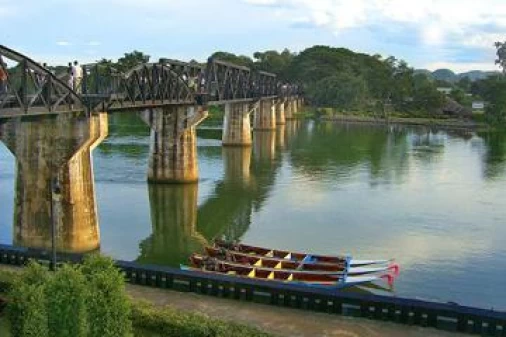
Bridge Over the River Kwai (Kanchanaburi)
Kanchanaburi, in Myanmar border, is home to the famous Bridge River Kwai. During WW II, Japan constructed...
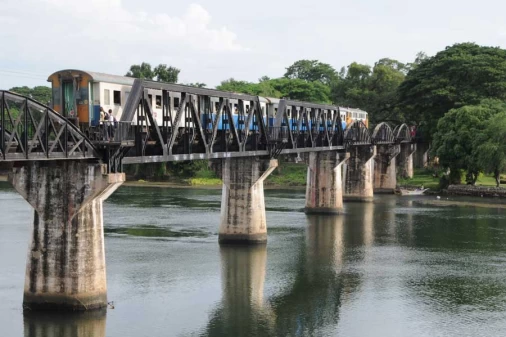
Death Railway Bridge
Descriptions: This 300m-long bridge is heavy with the history of the Thailand–Burma Railway, the construction...
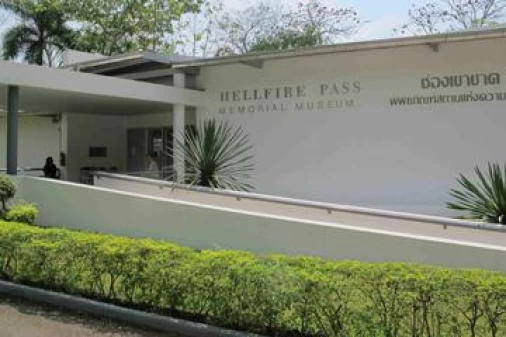
Hellfire Pass Museum (Kanchanaburi)
This Australian built complex consists of a memorial site located within Konyu Cutting (Hellfire Pass),...
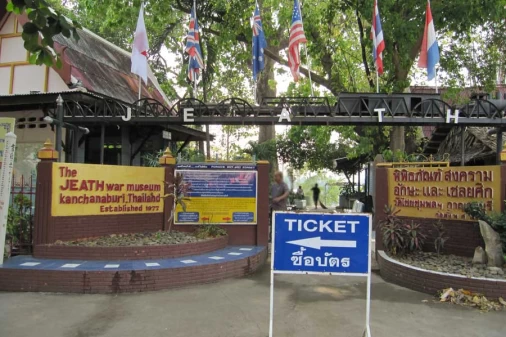
JEATH War Museum
Descriptions: Pieced together in 1977 by the abbot of Wat Chaichumpon, the JEATH War Museum was among...
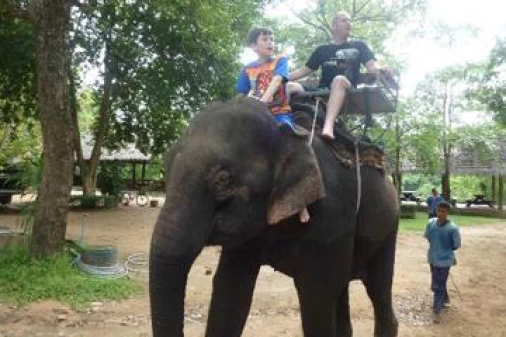
Taweechai Elephant Camp (Kanchanaburi)
Taweechai Elephant Camp is one of the largest elephant camps in Thailand. In operations since 1999,...

Thailand–Burma Railway Centre
The Thailand-Burma Railway Centre is mainly the work of one visionary and Death Railway researcher/historian:...
 France
France  Spain
Spain  German
German  Italian
Italian 

 Vietnam Tours
Vietnam Tours  Cambodia Tours
Cambodia Tours  Myanmar tours
Myanmar tours  Thailand Tours
Thailand Tours  Laos Tours
Laos Tours